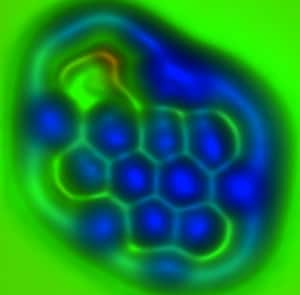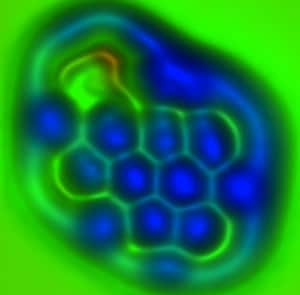
Scanning probe microscopy (SPM) is one of the principal paths to atomically precise manufacturing (molecular manufacturing). One of the varieties of SPM that shows great promise is noncontact atomic force microscopy (NC-AFM). In a significant milestone, a team of scientists at IBM has greatly expanded the capabilities of NC-AFM by providing unprecedented information about the length and strength of individual chemical bonds within molecules. A hat tip to ScienceDaily for reprinting this IBM press release “IBM Scientists First to Distinguish Individual Molecular Bonds“:
IBM (NYSE: IBM) scientists have been able to differentiate the chemical bonds in individual molecules for the first time using a technique known as noncontact atomic force microscopy (AFM).
The results push the exploration of using molecules and atoms at the smallest scale and could be important for studying graphene devices, which are currently being explored by both industry and academia for applications including high-bandwidth wireless communication and electronic displays.
“We found two different contrast mechanisms to distinguish bonds. The first one is based on small differences in the force measured above the bonds. We expected this kind of contrast but it was a challenge to resolve,” said IBM scientist Leo Gross. “The second contrast mechanism really came as a surprise: Bonds appeared with different lengths in AFM measurements. With the help of ab initio calculations we found that the tilting of the carbon monoxide molecule at the tip apex is the cause of this contrast.”
As reported in the cover story of the September 14th issue of Science magazine [abstract], IBM Research scientists imaged the bond order and length of individual carbon-carbon bonds in C60, also known as a buckyball for its football shape and two planar polycyclic aromatic hydrocarbons (PAHs), which resemble small flakes of graphene. The PAHs were synthesized by Centro de Investigacion en Quimica Bioloxica e Materiais Moleculares (CIQUS) at the Universidade de Santiago de Compostela and Centre National de la Recherche Scientifique (CNRS) in Toulouse.
The individual bonds between carbon atoms in such molecules differ subtly in their length and strength. All the important chemical, electronic, and optical properties of such molecules are related to the differences of bonds in the polyaromatic systems. Now, for the first time, these differences were detected for both individual molecules and bonds. This can increase basic understanding at the level of individual molecules, important for research on novel electronic devices, organic solar cells, and organic light-emitting diodes (OLEDs). In particular, the relaxation of bonds around defects in graphene as well as the changing of bonds in chemical reactions and in excited states could potentially be studied.
As in their earlier research (Science 2009, 325, 1110, abstract) the IBM scientists used an atomic force microscope (AFM) with a tip that is terminated with a single carbon monoxide (CO) molecule. This tip oscillates with a tiny amplitude above the sample to measure the forces between the tip and the sample, such as a molecule, to create an image. The CO termination of the tip acts as a powerful magnifying glass to reveal the atomic structure of the molecule, including its bonds. This made it possible to distinguish individual bonds that differ only by 3 picometers or 3 × 10-12 meters, which is about one-hundredth of an atom’s diameter. …
The images made soon after AFM was invented in 1986 did not achieve atomic resolution, so the achievement of picometer-level resolution is indeed an impressive accomplishment. It will be interesting to see if greater precision in imaging will lead to greater precision in manipulation of atoms and individual chemical bonds.
—James Lewis, PhD
